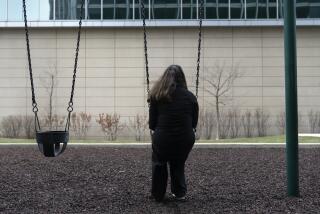First, the right diagnosis
- Share via
Some 16% of adults in the United States have met the diagnostic criteria for major depressive disorder at some point in their lives. Such rates have not really changed over the last few decades, according to studies -- but rates of treatment have risen dramatically.
Doctors say the wider recognition of depression as a chronic, recurring disease has helped people in need get necessary and helpful treatment. Better insurance coverage of mental health services and the explosion of new medications for depression since the introduction of Prozac in 1987 have helped fuel the rise in treatment rates.
And yet a wave of concern persists about overdiagnosis and overtreatment of depression. Has easy treatment in the form of a pill led to frivolous prescribing habits?
Here’s a closer look at precisely who is getting treated for depression in America.
First, a definition: People suffering from clinical depression experience feelings of overwhelming sadness, guilt and worthlessness and don’t find pleasure in their daily lives. They often sleep poorly and don’t eat enough -- or they sleep more and eat more than usual. They may be unable to work or function in social settings. They may entertain suicidal thoughts. For this state of mind to be termed clinical depression, symptoms must persist for at least two weeks.
“We have all experienced something that resembles what someone with major depression has,” says Dr. Benjamin Druss, a health policy researcher at Emory University in Atlanta. “But at the top end of the spectrum it’s something that’s very serious and debilitating. It’s more unlike than like the daily ups and downs that we all have.”
A complicated story
So how many of them get treated? In a 2005 study published in the New England Journal of Medicine, researchers assessed trends in prevalence and treatment of mental health (not just depression) from two large, national surveys -- 5,388 adult participants in 1990-92 and 4,319 in 2001-03.
In both time periods, about 30% of participants reported symptoms in the prior 12 months that met diagnostic criteria for a mental disorder.
In the early 1990s, 12.2% of all responders had received treatment for a mental disorder in the previous year; in the early 2000s, that percentage increased to 20.1%.
At first glance, this seems like an entirely good thing -- that more people with mental health problems were getting treatment as time went on.
In fact, the story’s more complicated than that. The study revealed a mismatch between those who needed treatment and those who received it. About half of the adults who suffered from a mental disorder never received any kind of treatment, says Dr. Philip Wang, deputy director of the National Institute on Mental Health and a co-author on the study. This suggests that there’s still a treatment gap.
(The researchers defined treatment very loosely and included such things as alternative treatments, herbal medicines and talking to one’s religious leader, Wang says.)
An earlier study in 2003 used data from the 2001-2003 survey to look at depression specifically. Of the more than 9,000 U.S. adults surveyed, 6.6% were found to have met diagnostic criteria for major depressive disorder in the previous year. Among those, 57% received some kind of treatment (again, defined loosely). Among those cases classified as very severe, the treatment rate was 70%.
“These are people who are really impaired -- or suicidal,” Wang says. The fact that 30% of them aren’t receiving any care shows that undertreatment is still a big issue, he says.
Treatment quality
Wang’s study also assessed quality of treatment, measured partly by how many visits were made to providers. Evidence-based treatment guidelines suggest a minimum of four visits is needed when patients are prescribed antidepressant medication and a minimum of eight visits for psychotherapy to be effective. The findings? “It’s not just that people don’t get treated. When you look at what they’re getting, most of the treatments are of low quality, or there’s not evidence that they’re effective,” Wang says.
But if some who need treatment are falling through the cracks, perhaps others are being treated without need.
In the 2005 study (the one that surveyed for any mental health condition), only half of those respondents who received treatment met the diagnostic criteria for a mental disorder. Druss says such findings show up in many epidemiological studies.
But that doesn’t automatically mean that treating those people is inappropriate, he adds. He has taken a closer look at survey data and found that at least half of the people receiving treatment who lacked diagnosable symptoms had reported them in the past -- just not in the last 12 months.
“There is some sense that when people have had more than one or two depressive episodes that it may be safest to keep them on an antidepressant, for instance, to prevent recurrence,” he says.
Another quarter of the apparently overtreated population had symptoms that were serious but fell below the threshold for diagnosing a mental disorder or had had “some kind of big stress in their lives,” Druss says.
In the remaining segment of people, about 8% of all treated patients, Druss says, “the treatments they were getting were mostly outside the formal healthcare system.”
All in all, Druss says, his study (which was published in the Archives of General Psychiatry in 2007) found the problem of overtreatment to be smaller than the large survey data suggested.
The bestseller “Listening to Prozac,” published in 1993, famously extolled the benefits of antidepressants. Since then, “There’s been much more appreciation of how damaging depression is,” says Dr. Peter Kramer, a psychiatrist at Brown University in Providence, R.I., and the book’s author. The World Health Organization classifies depression as one of the most disabling diseases in the world.
“I know the arguments on the other side, that depression is overdiagnosed,” Kramer adds. “But if we look at depression the same way we look at other illnesses, the core disease seems better established in the scientific literature, and the lower levels also seem harmful. So I think there’s a legitimate case for doctors to treat it a little more liberally.”
That’s because someone who doesn’t quite meet diagnostic criteria for depression may still benefit from treatment, he says.
Noting the costs
Of course, there is also the issue of what liberal treatment does to healthcare costs. A 2003 study in the Journal of Clinical Psychiatry put the cost of depression at $83 billion annually in the U.S. However, less than one-third of that number came from healthcare costs.
“The lion’s share, close to two-thirds, results from indirect costs,” Wang says, such as loss of productivity, absenteeism and what he calls “presenteeism,” in which a depressed person may be at work, but is ineffectual.
In other words, most costs came from undertreatment or ineffective treatment.
Perhaps poorly managed treatment is the real problem, says Dr. Lon Schneider, professor of psychiatry at USC’s Keck School of Medicine.
“People get prescriptions,” he says, “but relatively few people get good evaluation and appropriate care based on that evaluation.”
--






